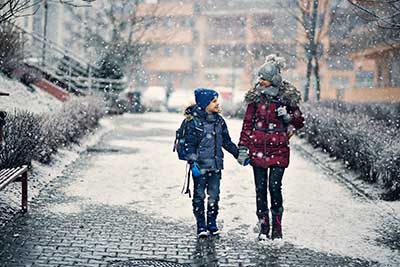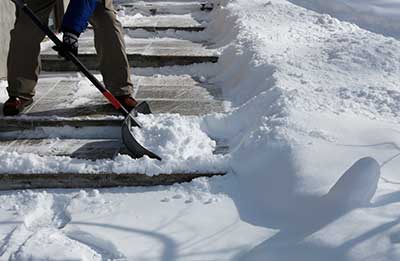
There is no mistaking the signs. The days are getting darker, the leaves have turned from green to gold, red and brown, and cooling temperatures have heralded the opening of coat and boot season. Maybe you have witnessed some of nature’s other, more subtler signs portending a harsh winter is coming. Originally published in the 1978 Farmer’s Almanac, the following are nature’s signals, seeped in folklore, that have long been used as predictors that bitter cold, heavy snow or a long, treacherous winter in on its way:
- Squirrels’ tails are bushier and they are aggressively busy—building nests and collecting acorns from an unusually abundant crop that has dropped on your lawn.
- Wooly bear caterpillars are fuzzier, more black than orange.
- The geese, ducks and monarch butterflies long ago left in an early, critical mass.
- Snowy owls arrived early though and woodpeckers are sharing trees.
- You have unannounced guests in your home—spiders are spinning large, gossamer webs, mice are chewing their way in through the drywall and crickets have settled on your hearth.
As sure as the earth will continue her orbit and tilt on her axis, winter is coming, regardless of whether you have noticed what nature’s winter lore is forecasting. The historical standby 2020 Farmer’s Almanac and our nation’s go to authority for all things atmosphere and weather related, the National Oceanic and Atmospheric Administration (NOAA), have published somewhat conflicting forecasts. Computer models predict anything and everything, from piles of snow and colder than average temperatures for some areas to wetter than average and not so cold for others.
The best anyone can do is be prepared. As we finish out 2019 and keep our fingers crossed for an early spring in 2020, below are some tips to keep you and your family safe at home, at work or out on the roads for whatever winter may come.
 Keep Warm
Keep Warm
- Keep skin covered in frigid temperatures and wear a hat to retain heat.
- Dress in layers of clothing. A wind and waterproof outer shell will keep you dry and inner sweat-wicking layers will help keep you warm.
- Mittens are more effective than gloves if outdoors for an extended time. Try to find those with a water-resistant outer shell to help get hands dry.
- Waterproof footwear and water-wicking, warm socks will protect your feet in cold and damp conditions. A thick tread on shoes or boots will provide stability on slick surfaces.
Be Prepared with Supplies
- Create and keep a winter emergency kit in your home. Include water, food, a flashlight, extra batteries, a radio, and generator if possible.
- Keep a portable disaster supply kit in your car in the event you are stranded—a first aid kit, water, nonperishable food items, flashlight and batteries, blankets, extra jacket and change of shoes.
 Prevent Slips and Falls
Prevent Slips and Falls
Fall injures are far more common during the winter because of frost, snow or ice creating slick surfaces. Water on shoes and dripping from umbrellas follows us indoors and causes slick conditions. You can help prevent injuries from slips and falls by:
- Being vigilant in removing snow and using deicing agents on walkways, stairs and parking lots.
- Wear weather appropriate footwear that provides warmth and traction.
- Pay attention to the ground you walk on. Go slow and be on the lookout for ice and slick surfaces.
Use Precautions and Be Aware
- Know the signs of frostbite. Your body’s extremities, hands and fingers, toes, ears, and nose, are at greater risk for frostbite when the temperatures fall below freezing. Seek medical attention if you notice signs of frostbite: numbness, flushed gray, white, blue or yellow skin discoloration and waxy feeling skin.
- Avoid hypothermia. Confusion, dizziness, exhaustion and shivering are signs of hypothermia. In extreme cold you may need to alter normal routines to protect yourself by reducing time outdoors. If you work outdoors or have employees who need to work outdoors ensure they are appropriately dressed and there are additional opportunities to get warm.
- Use portable heaters carefully and with great awareness. Follow manufacturer’s instructions. Ensure units are used in an appropriate, safe space and are not in proximity to flammable materials.
- Avoid frozen pipes by keeping your thermostat at the same temperature, run water at a trickle to keep it flowing through pipe and open cabinet doors to allow warm air to circulate around pipes.
Winter Driving Safety Best Practices
- Limit driving during extreme cold or during winter storms. Accidents are more likely to occur in icy weather, putting you at greater risk for injury and/or being stranded in frigid temperatures.
- Winterize your car for optimum visibility and performance in icy/snowy conditions. Ensure wiper blades, headlights and anti-icing fluid are well-maintained. Install snow tires on your vehicle for better traction when routinely driving in snow and icy environments.
- Allow at least three times more space than normally recommended between you and the car in front of you and drive a reduced speed in icy or wet conditions. Be especially cautious on bridges, overpasses and infrequently traveled roads where you are more likely to encounter slick ice.
- Avoid using cruise control or overdrive on icy roads. It is important to maintain personal control of the vehicle for quicker response in unpredictable conditions.
- Brake gently in icy or wet conditions to avoid skidding. Ease off the brake if the wheels start to lock up.
Stay vigilant, warm and safe!























